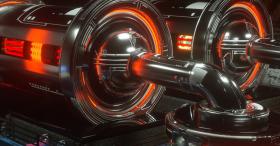Related
The vessel is propelled through space by different engine systems for travel between and within star systems.
Engineering systems are responsible for the core operations of the ship, including power generation, propulsion and life support.
The vessel’s Power Distribution Network (PDN) is a highly redundant, layered distribution system for delivering power from generation and auxiliary power sources to vessel systems.
The system is made up of a network of electrical conduits which link distribution nodes, creating a web-like network that provides multiple paths between power sources and consuming systems. Power can be routed around the network to meet operating requirements or to bypass damage and is transformed to the voltages and frequencies required by various vessel systems.
The PDN also monitors and reports on the status of the systems connected to it.
Structure
The Power Distribution Network is layered, with the first layer (the primary distribution network) providing maximum distribution capacity between primary generation sources and first-layer distribution nodes. Some high-consumption systems such as propulsion are supplied directly from the primary network.
From the first-layer distribution nodes, a second layer (the secondary distribution network) uses a range of smaller-capacity conduits to deliver power to distribution nodes closer to the systems consuming it.
Distribution Nodes
Distribution nodes receive power from up to three sources via an upstream interface. The supplied power is aggregated and converted to the required distribution standard (voltage and current) which can then be delivered to up to three destinations via a downstream interface.
Each node has a configuration interface that allows power allocation between downstream outputs to be adjusted, which determines how much power the connected downstream nodes receive.
Some nodes are supply only (such as generators).
Node Priority
Nodes can accept up to three supply inputs and can output up to three downstream systems.
The three outputs are prioritised, with the first output having the highest priority. If available power drops below what has been allocated, power will be unallocated from the lowest priority output first.
System Nodes
System nodes are vessel systems which only consume power and aren't involved in distribution. Power management for system nodes can be configured from the relevant system's control console.
Conduits
Distribution nodes are connected by conduits.
The voltage and current that can be handled by each conduit is limited by the physical parameters of the conduit (for example the size of the cable cores making up the conduit, their insulation and shielding, etc).
Conduits typically have significant redundant capacity over that needed for their nominal distribution role to support additional load due to alternative routing of power around damage.
Power Standards
Primary Distribution Network (1DN)
The DC output of the reactor is immediately regulated to medium voltage (1000V) DC. This is distributed via the Primary Distribution Network (1DN), consisting of a relatively small number of high-capacity conduits linking generation systems to layer-one distribution nodes and directly to propulsion systems.
The network includes redundant conduits which are installed along physically different routes throughout the vessel to minimise the effect of damage on the network’s minimum delivery capacity.
Secondary Distribution Network (2DN)
The Secondary Distribution Network (2DN) consists of a large number of lengthy mid-capacity conduits linking distribution nodes with distribution boards supplying vessel systems.
The DC supply from the 1DN is inverted to AC at the distribution node. Depending on the downstream requirement, inversion will be to either high-frequency (400Hz) or low frequency (50Hz) AC.
400Hz Secondary Distribution Network
The high-frequency 400Hz 2DN is an AC system rated at 440 volts.
High-frequency AC (HFAC) power offers advantages over standard frequency AC in a number of applications:
- Electric equipment can be much smaller and lighter. For example, doubling frequency generally permits electric machines to be 75% smaller. Other grid components (such as transformers, filters and circuit breakers) can also be smaller.
- Electric motors can achieve higher speeds. High-speed induction motors can be directly used for compressors, high pressure pumps and turbines.
- Acoustic noise is reduced dramatically due to a higher frequency mechanical vibration.
- Harmonics in HFAC systems are at a higher frequency and so are more easily removed by filters.
HFAC presents grid safety challenges. Circuit breakers must react faster to overload conditions in high frequency transmission scenarios to prevent damage.
50Hz Secondary Distribution Network
The standard frequency 50Hz 2DN is a three-phase AC system rated at 240 volts. Most supplied systems use a single phase, with the use of individual phases limiting cross-system interference.
Network Management
Each PDN node can be managed remotely from engineering consoles. This includes the ability to reallocate power between upstream sources and downstream nodes, and diagnostic monitoring.
Monitoring
The condition of each node is monitored. Alerts or alarms are displayed on the master systems panel.
Mapping
The PDN is visualised as a schematic map on a dedicated console configuration, viewable in different sections or from the perspective of each major system. The PDN map provides direct access to the control interface for each node.
Systems Telemetry
Each system connected to a PDN node passes telemetry to the node on the system's condition. This allows connected systems to also be monitored on the master systems panel as well as by the master systems indicators on any console managing that system.





